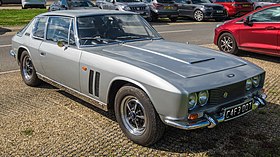| Jensen FF | |
|---|---|
 | |
| Overview | |
| Manufacturer | Jensen Motors |
| Production | 1966–1971 320 produced[1] |
| Assembly | West Bromwich, England |
| Designer | Federico Formenti at Carrozzeria Touring Superleggera |
| Body and chassis | |
| Class | Grand tourer |
| Body style | 2-door 4-seat coupé |
| Layout | Front-engine, four-wheel-drive |
| Related | Jensen Interceptor |
| Powertrain | |
| Engine | 6,277 cc (6.3 L; 383.0 cu in) [Chrysler 383] V8 |
| Transmission | 3-speed TorqueFlite A727 automatic[2] |
| Dimensions | |
| Wheelbase | 109 in (2,769 mm)[3] |
| Length | 191 in (4,851 mm)[3] |
| Width | 69 in (1,753 mm)[3] |
| Height | 55 in (1,397 mm)[3][4] |
| Kerb weight | 3,808 lb (1,727 kg) |
The Jensen FF is a four-wheel drive grand tourer produced by British car manufacturer Jensen Motors between 1966 and 1971. It was the first non all-terrain production car equipped with four-wheel drive[1] and an anti-lock braking system. The powertrain was sourced from Chrysler, installing the second generation 6,277 cc (6.3 L; 383.0 cu in) V8 engine and 3-speed TorqueFlite A727 automatic transmission.
The use of four-wheel drive in a passenger car preceded the successful AMC Eagle by thirteen years, the Audi Quattro by fourteen years, and the Subaru Leone by five years. The Dunlop Maxaret mechanical anti-lock braking system had previously been used only on aircraft, lorries, and racing cars. An experimental version was first fitted to the earlier Jensen C-V8, but this did not go into production.
The letters FF stand for Ferguson Formula, after Ferguson Research Ltd., who invented the car's four-wheel drive system. The FF is related to the similar-looking, rear-wheel drive Jensen Interceptor, but is 127 mm (5.0 in) longer, and mechanically very different.
Standard FF features included front seat belts, a tachometer, and map pockets.[5]
- ^ a b Robson, Graham (2006). A to Z British cars 1945–1980. Devon, UK: Herridge. ISBN 0-9541063-9-3.
- ^ "Jensen FF Mk1 119/134". home.online.no. Archived from the original on 9 September 2005. Retrieved 11 February 2008. Archived 9 September 2005 at the Wayback Machine
- ^ a b c d Culshaw; Horrobin (1974). Complete Catalogue of British Cars. London: Macmillan. ISBN 0-333-16689-2.
- ^ Cardew, Basil (1966). Daily Express Review of the 1966 Motor Show. London: Beaverbrook Newspapers Ltd.
- ^ http://www.british-steel.org/brochure/ff/ffa_1_l.jpg Archived 4 March 2016 at the Wayback Machine [bare URL image file]